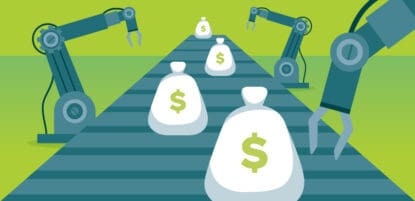CFOs have been slow to realize the opportunities FinTech is creating in accounts payable.
Earlier this year, a study by the Project Management Institute revealed that $1 million is wasted every 20 seconds by organizations around the world.
While factors like employee turnover and market disruption make entirely lean operations a challenge, it’s safe to say that CFO’s are still looking at a big opportunity to shed inefficiency off of its business’s internal operations.
Accounts payable represents the greatest opportunity for improved efficiency in organizations today.
Considering that accounts payable has remained almost an entirely manual process in many businesses, and still features the prominent use of paper checks, there is a tremendous amount of low-hanging fruit for CFOs to easily start picking from. Yet, many have not yet capitalized.
According to Marsh, 24% of businesses have not yet adopted any disruptive technology, and 46% are leveraging just 1-3 disruptive technologies. These numbers exist in spite of the well-documented opportunities that come with the simple implementation of accounts payable automation software.
Here are a few of the greatest benefits CFOs who lead an outdated approach to accounts payable are missing out on:
1) You can improve command over your short-term cash flow by paying vendors electronically
Paying vendors with commercial credit cards that offer cash-back rebates can give your bottom line a steady surge of income to improve short-term cash flow, and also provide working capital extensions that are made available through their credit line.
In spite of these benefits, less than half of the respondents in a recent survey indicated that they make at least 10% of their B2B payments on credit cards.
2) You can create time for more strategic projects by automating data capture and payment approvals
The end-to-end accounts payable process represents a steady drain on a business’s resources in ways that are not-so-obvious. Here are the main components driving time costs in invoice processing and payment:
- Hand-delivering or emailing each invoice to a department head for approval
- Typing data from the invoice into your accounting system
- Waiting on the CFO to approve the payment
- Writing and postmarking the check
- Reconciling any mistakes that may have been made in the process
When you consider that AP managers go through this whole process 100 times every month, it’s challenging to see how they have time for anything else. Often times, they don’t, and will need to work late to ensure all payments are made on time.
By leveraging accounts payable automation technology, businesses have been able to earn back 64 hours every month that they can dedicate to projects that can create efficiencies in human resource operations, T&E reporting, or any other part of the business.
3) You can easily set up payment controls that drastically reduce fraud risk
Payment controls like segregation of duties and dual factor authentication have become table stakes everywhere in the world of information security. That is, everywhere except for accounts payable.
Today, a staggering 85% of IT security professionals at SMEs are not confident that their companies have sufficient technology in place to protect against the relentless risk of fraud. And these premonitions seems fully justified by the AFP’s discovery that 78% of businesses experienced attempted and/or actual payments fraud in 2017.
As it turns out, these basic payment controls are very difficult to manage on an ad-hoc and manual basis.
However, businesses leveraging accounts payable automation technology can build these payment controls, and more, into their vendor payment process without ever needing to think twice about them.
To see how simple a transition to automation-based accounts payable processing would be for your team, schedule a personalized demo with MineralTree.



